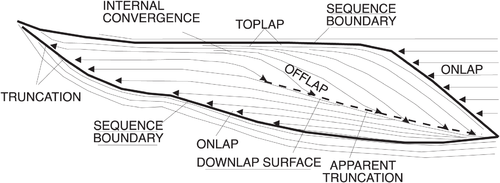Seismic sequence analysis
| Exploring for Oil and Gas Traps | |

| |
| Series | Treatise in Petroleum Geology |
|---|---|
| Part | Predicting the occurrence of oil and gas traps |
| Chapter | Exploring for stratigraphic traps |
| Author | John C. Dolson, Mike S. Bahorich, Rick C. Tobin, Edward A. Beaumont, Louis J. Terlikoski, Michael L. Hendricks |
| Link | Web page |
| Store | AAPG Store |
Objective
The objective of seismic sequence analysis is to identify depositional sequences and systems tracts on seismic sections by interpreting the location of their boundaries. Boundaries are manifested as discontinuities in seismic sections and are located mainly by finding reflection terminations.[1]
Procedure
Follow the steps listed below to perform a sequence analysis of a seismic section (adapted from Vail[1]).
- Look for places where two reflectors converge. Where reflectors converge, there will be terminations.
- Mark the reflection terminations with arrows.
- Draw in the discontinuity surface between the onlapping and downlapping reflections above, and the truncating and toplapping reflectors above. If the discontinuity surface becomes conformable, trace its position across the section by reflection correlation.
- Continue the process described in steps 1, 2, and 3 for all the seismic lines in the grid.
- Close all seismic grid loops by checking the loop ties for each discontinuity or its correlative equivalent.
- Categorize each discontinuity.
- If it is characterized by regional onlap above and truncation below then it is probably a sequence boundary
- If it is characterized by regional downlap then it is most likely a downlap surface
Marking a seismic section, marking
The table below shows suggested colors for marking seismic sections during sequence analysis (after Vail[1]).
| Feature | Color |
|---|---|
| Reflection terminations and reflection patterns | Red |
| Downlap surfaces | Green |
| Transgressive surfaces | Blue |
| Sequence boundaries | Miscellaneous |
Reflection terminations
The table below groups termination patterns by position with respect to a discontinuity.
| Reflection termination point | Pattern | Associated discontinuity |
|---|---|---|
| Above a discontinuity | Onlap | Sequence boundary (unconformity) |
| Downlap | Downlap surface (condensed section) | |
| Below a discontinuity | Truncation | Sequence boundary |
| Toplap | Sequence boundary | |
| Apparent truncation | Downlap surface |
Locating reflection terminations
Locating reflection termination is a matter of finding the patterns described in the table above. Figure 1 shows these patterns and the associated discontinuity surfaces.
See also
- Geometrical analysis
- Procedure for geometrical analysis
- Other correlation features
- Well log sequence analysis
- Combining well log with seismic sequence analysis
References
- ↑ 1.0 1.1 1.2 Vail, P. R., 1987, Seismic stratigraphy interpretation procedure, in A. W. Bally, ed., Atlas of seismic stratigraphy: AAPG Studies in Geology 27, p. 1-10.
